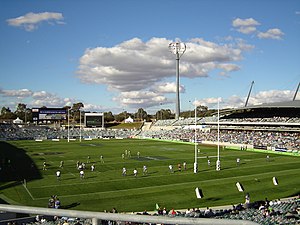Canberra Stadium
| Canberra Stadium | |
|---|---|

|
|
| Rugby match at Canberra Stadium | |
| Earlier names | |
|
Bruce Stadium |
|
| Data | |
| place |
|
| Coordinates | 35 ° 15 ′ 0 ″ S , 149 ° 6 ′ 9 ″ E |
| owner | Australian Sports Commission |
| opening | 1977 |
| Renovations | 1997 |
| surface | Natural grass |
| architect | Phillip Cox & Partners |
| capacity | 25,011 places |
| Societies) | |
| Events | |
The Canberra Stadium is a stadium in the Australian capital Canberra . Located in the Bruce neighborhood next to the Australian Institute of Sport , it was initially named after former Prime Minister Stanley Bruce and is mainly used for rugby games.
The sports facility is equipped with seats and offers 25,011 seats for visitors in the stands. The largest audience, however, was 28,753; this was achieved at the finals of the Super 12 Rugby League in 2004. The main stand of Canberra Stadium is named after the legendary rugby league player Mal Meninga , and at the entrance to the main stand there is a statue of the player Laurie Daley .
The stadium is currently owned by the Australian government, which has leased it to the Australian Capital Territory (ACT) government through the Australian Sports Commission . The current lease runs until 2010; the ACT government seeks to acquire possession of the stadium through land swaps with the Australian government.
history
The stadium was built in 1977 with an initial capacity of 8,000 seats to host the Pacific Conference Games . During the first few years, athletics competitions were held here regularly . On October 6, 1985, the East German Marita Koch set a world record in the 400-meter run during the Athletics World Cup , which is still valid today. Previously, the stadium was expanded to a capacity of 11,500 in view of this competition.
Canberra Stadium has been home to several local sports clubs such as the Canberra Arrows / Cosmos (soccer) and the Canberra Bushrangers (baseball). After the athletics facility was removed in 1990, the Canberra Raiders rugby league team moved in , followed by the Brumbies rugby union team in 1996 .
In 1997, a major renovation and expansion of the stadium was carried out with a view to hosting some of the games of the 2000 Summer Olympics football tournament in Sydney . The total cost of the renovations totaled 82 million AUD , estimated nearly seven times as much as originally described by the government of the ACT. The controversy that followed led to the resignation of Kate Carnell , then Chief Minister , two weeks after the end of the Summer Olympics .
In 1981 and 1993, the stadium was the venue for the Junior World Cup, which was held in Australia . Also during the Rugby Union World Cup 2003 some preliminary round matches took place here. In 2015, the stadium will host the Asian Football Championship .
At the end of October 2013 it was announced that the naming rights to the stadium were sold to the insurance company GIO Insurance Australia. It is the first sponsorship deal for the stadium name. The value of the four-year contract is around 255,000 euros (350,000 AUD). As of January 1, 2014, the sports facility will officially be named GIO Stadium Canberra .
Web links
- canberrastadium.com: Official website (English)
- austadiums.com: stadium history and data (English)
- stadionwelt.de: picture gallery
swell
- ↑ austadiums.com: stadium capacity (English)
- ↑ austadiums.com: Canberra Stadium - History (English)
- ↑ stadionwelt.de: Canberra Stadium: naming rights sold items from November 3, 2013
- ↑ canberrastadium.com.au: Canberra Stadium, announces new naming right sponsor article from October 24, 2013 (English)


